Guangdong
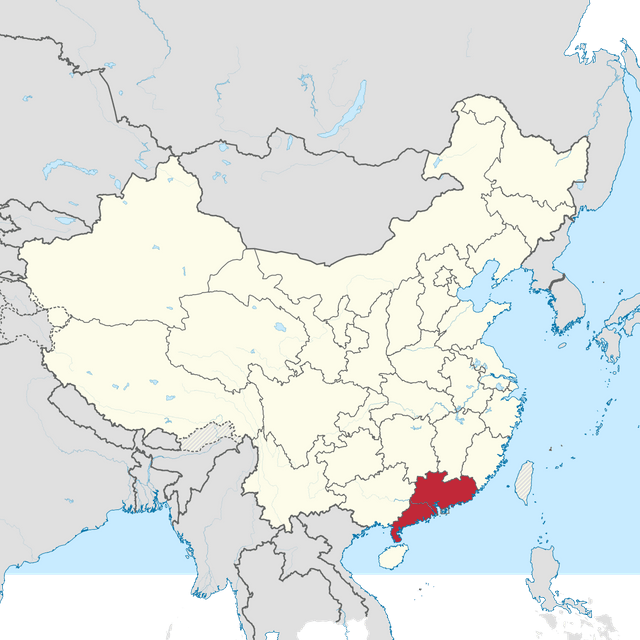
Guangdong

Guangdong Province 广东省 | |||||||||||||||||||||||||||||||||||||||||||||||||||||||||||||
|---|---|---|---|---|---|---|---|---|---|---|---|---|---|---|---|---|---|---|---|---|---|---|---|---|---|---|---|---|---|---|---|---|---|---|---|---|---|---|---|---|---|---|---|---|---|---|---|---|---|---|---|---|---|---|---|---|---|---|---|---|---|
| Name transcription(s) | |||||||||||||||||||||||||||||||||||||||||||||||||||||||||||||
| • Chinese | 广东省(Guǎngdōng Shěng) | ||||||||||||||||||||||||||||||||||||||||||||||||||||||||||||
| • Abbreviation | GD /粤(pinyin: Yuè, Jyutping: Jyut6) | ||||||||||||||||||||||||||||||||||||||||||||||||||||||||||||
| Coordinates:23°24′N 113°30′E [74] | |||||||||||||||||||||||||||||||||||||||||||||||||||||||||||||
| Named for | Abbreviated from "Guǎngnándōng Lù" (A "lù" was equal to a province or a state in Song China) 广= wide, vast, expanse 东= east literally, "At the East of the Expanse" (Guangxi being the West) | ||||||||||||||||||||||||||||||||||||||||||||||||||||||||||||
| Capital (and largest city) | Guangzhou | ||||||||||||||||||||||||||||||||||||||||||||||||||||||||||||
| Divisions | ****21 prefectures, 121 counties, 1642 townships | ||||||||||||||||||||||||||||||||||||||||||||||||||||||||||||
| Government | |||||||||||||||||||||||||||||||||||||||||||||||||||||||||||||
| • Secretary | Li Xi | ||||||||||||||||||||||||||||||||||||||||||||||||||||||||||||
| • Governor | Ma Xingrui | ||||||||||||||||||||||||||||||||||||||||||||||||||||||||||||
| Area | |||||||||||||||||||||||||||||||||||||||||||||||||||||||||||||
| • Total | 179,800 km2(69,400 sq mi) | ||||||||||||||||||||||||||||||||||||||||||||||||||||||||||||
| Area rank | 15th | ||||||||||||||||||||||||||||||||||||||||||||||||||||||||||||
| Highest elevation | 1,902 m (6,240 ft) | ||||||||||||||||||||||||||||||||||||||||||||||||||||||||||||
| Population (2018)[12] | |||||||||||||||||||||||||||||||||||||||||||||||||||||||||||||
| • Total | 113,460,000[10] | ||||||||||||||||||||||||||||||||||||||||||||||||||||||||||||
| • Rank | 1st | ||||||||||||||||||||||||||||||||||||||||||||||||||||||||||||
| • Density rank | 7th | ||||||||||||||||||||||||||||||||||||||||||||||||||||||||||||
| Demographics | |||||||||||||||||||||||||||||||||||||||||||||||||||||||||||||
| • Ethnic composition | Han – 99% Zhuang – 0.7% Yao – 0.2% | ||||||||||||||||||||||||||||||||||||||||||||||||||||||||||||
| • Languages and dialects | Cantonese and other Yue languages, Hakka, Min Nan languages (Teochew & Leizhou Min), Tuhua, Mandarin, Zhuang | ||||||||||||||||||||||||||||||||||||||||||||||||||||||||||||
| ISO 3166 code | CN-GD | ||||||||||||||||||||||||||||||||||||||||||||||||||||||||||||
| GDP(2018) | CNY 9.73 trillion US$1.47 trillion[10] (1st) | ||||||||||||||||||||||||||||||||||||||||||||||||||||||||||||
| • per capita | CNY 87,763 US$13,257 (8th) | ||||||||||||||||||||||||||||||||||||||||||||||||||||||||||||
| HDI(2017) | 0.786[13] (high) (5th) | ||||||||||||||||||||||||||||||||||||||||||||||||||||||||||||
| Website | www.gd.gov.cn [75](in Chinese) | ||||||||||||||||||||||||||||||||||||||||||||||||||||||||||||
| Guangdong | |||||||||||||||||||||||||||||||||||||||||||||||||||||||||||||
 "Guangdong" in Simplified (top) and Traditional (bottom) Chinese characters | |||||||||||||||||||||||||||||||||||||||||||||||||||||||||||||
| Simplified Chinese | 广东 | ||||||||||||||||||||||||||||||||||||||||||||||||||||||||||||
| Traditional Chinese | 廣東 | ||||||||||||||||||||||||||||||||||||||||||||||||||||||||||||
| Literal meaning | "Eastern Expanse" | ||||||||||||||||||||||||||||||||||||||||||||||||||||||||||||
| |||||||||||||||||||||||||||||||||||||||||||||||||||||||||||||
| Abbreviation | |||||||||||||||||||||||||||||||||||||||||||||||||||||||||||||
| Simplified Chinese | 粤 | ||||||||||||||||||||||||||||||||||||||||||||||||||||||||||||
| Traditional Chinese | 粵 | ||||||||||||||||||||||||||||||||||||||||||||||||||||||||||||
| Literal meaning | [an ancient name for southern China's Yue people] | ||||||||||||||||||||||||||||||||||||||||||||||||||||||||||||
| |||||||||||||||||||||||||||||||||||||||||||||||||||||||||||||
Guangdong (also known as Canton Province and alternately romanized as Kwangtung) is a coastal province in South China on the north shore of South China Sea. Its capital of the province is Guangzhou. With a population of 113.46 million (as of 2018[14]) across a total area of about 179,800 km2 (69,400 sq mi),[11] Guangdong is the most populous province of China and the 15th-largest by area. Its economy is larger than that of any other province in the nation and the 6th largest sub-national economy in the world with a GDP size of 1.47 trillion US dollars (9.73 trillion Chinese yuan) in 2018.[14] The Pearl River Delta Economic Zone, a Chinese megalopolis, is a core for high technology, manufacturing and foreign trade. Located in this zone are two of the four top Chinese cities and the top two Chinese prefecture-level cities by GDP; Guangzhou, the capital of the province, and Shenzhen, the first special economic zone in the country. These two are among the most populous and important cities in China, and have now become two of the world's most populous megacities.
The province of Guangdong surpassed Henan and Shandong to become the most populous province in China in January 2005, registering 79.1 million permanent residents and 31 million migrants who lived in the province for at least six months of the year;[15][16] the total population was 104,303,132 in the 2010 census, accounting for 7.79 percent of Mainland China's population.[17] This makes it the most populous first-level administrative subdivision of any country outside of South Asia, as its population is surpassed only by those of the Pakistani province of Punjab[18] and the Indian states of Bihar, Maharashtra and Uttar Pradesh.[19] Its population increase since the census has been modest, the province registering 108,500,000 people in 2015.[20] Most of the historical Guangdong Province is administered by the People's Republic of China (PRC). However, the archipelagos of Pratas in the South China Sea are controlled by the Republic of China (ROC, a.k.a. Taiwan), and were previously part of Guangdong Province before the Chinese Civil War.[21][22]
Guangdong has a highly diversified economy. Since 1989, Guangdong has topped the total GDP rankings among all provincial-level divisions, with Jiangsu and Shandong second and third in rank. As of 2018, Guangdong's GDP reached 1.47 trillion US dollars (CNY 9.73 trillion), exceeding that of Spain with GDP of 1.43 trillion US dollars, the 13th largest in the world.[23] The province contributes approximately 12% of the total economic output of mainland China, and is home to the production facilities and offices of a wide-ranging set of Chinese and foreign corporations. Guangdong has benefited from its proximity to the financial hub of Hong Kong, which it borders to the south. Guangdong also hosts the largest import and export fair in China, the Canton Fair, hosted in the provincial capital of Guangzhou.
After the unification of Lingnan region in the Qin Dynasty, the immigrants from the Central Plains moved in and formed the local culture with a unique style. With the outward movement of the Guangdong people, the Hakka and Cantonese languages, music, cuisine, opera and tea ceremony have been spread throughout the nation, Southeast Asia and other countries. The two special administrative regions of Hong Kong and Macao fall within the scope of Guangdong cultural influence, and Guangdong culture still has profound influences on the Chinese in Singapore and Malaysia.
Guangdong Province 广东省 | |||||||||||||||||||||||||||||||||||||||||||||||||||||||||||||
|---|---|---|---|---|---|---|---|---|---|---|---|---|---|---|---|---|---|---|---|---|---|---|---|---|---|---|---|---|---|---|---|---|---|---|---|---|---|---|---|---|---|---|---|---|---|---|---|---|---|---|---|---|---|---|---|---|---|---|---|---|---|
| Name transcription(s) | |||||||||||||||||||||||||||||||||||||||||||||||||||||||||||||
| • Chinese | 广东省(Guǎngdōng Shěng) | ||||||||||||||||||||||||||||||||||||||||||||||||||||||||||||
| • Abbreviation | GD /粤(pinyin: Yuè, Jyutping: Jyut6) | ||||||||||||||||||||||||||||||||||||||||||||||||||||||||||||
| Coordinates:23°24′N 113°30′E [74] | |||||||||||||||||||||||||||||||||||||||||||||||||||||||||||||
| Named for | Abbreviated from "Guǎngnándōng Lù" (A "lù" was equal to a province or a state in Song China) 广= wide, vast, expanse 东= east literally, "At the East of the Expanse" (Guangxi being the West) | ||||||||||||||||||||||||||||||||||||||||||||||||||||||||||||
| Capital (and largest city) | Guangzhou | ||||||||||||||||||||||||||||||||||||||||||||||||||||||||||||
| Divisions | ****21 prefectures, 121 counties, 1642 townships | ||||||||||||||||||||||||||||||||||||||||||||||||||||||||||||
| Government | |||||||||||||||||||||||||||||||||||||||||||||||||||||||||||||
| • Secretary | Li Xi | ||||||||||||||||||||||||||||||||||||||||||||||||||||||||||||
| • Governor | Ma Xingrui | ||||||||||||||||||||||||||||||||||||||||||||||||||||||||||||
| Area | |||||||||||||||||||||||||||||||||||||||||||||||||||||||||||||
| • Total | 179,800 km2(69,400 sq mi) | ||||||||||||||||||||||||||||||||||||||||||||||||||||||||||||
| Area rank | 15th | ||||||||||||||||||||||||||||||||||||||||||||||||||||||||||||
| Highest elevation | 1,902 m (6,240 ft) | ||||||||||||||||||||||||||||||||||||||||||||||||||||||||||||
| Population (2018)[12] | |||||||||||||||||||||||||||||||||||||||||||||||||||||||||||||
| • Total | 113,460,000[10] | ||||||||||||||||||||||||||||||||||||||||||||||||||||||||||||
| • Rank | 1st | ||||||||||||||||||||||||||||||||||||||||||||||||||||||||||||
| • Density rank | 7th | ||||||||||||||||||||||||||||||||||||||||||||||||||||||||||||
| Demographics | |||||||||||||||||||||||||||||||||||||||||||||||||||||||||||||
| • Ethnic composition | Han – 99% Zhuang – 0.7% Yao – 0.2% | ||||||||||||||||||||||||||||||||||||||||||||||||||||||||||||
| • Languages and dialects | Cantonese and other Yue languages, Hakka, Min Nan languages (Teochew & Leizhou Min), Tuhua, Mandarin, Zhuang | ||||||||||||||||||||||||||||||||||||||||||||||||||||||||||||
| ISO 3166 code | CN-GD | ||||||||||||||||||||||||||||||||||||||||||||||||||||||||||||
| GDP(2018) | CNY 9.73 trillion US$1.47 trillion[10] (1st) | ||||||||||||||||||||||||||||||||||||||||||||||||||||||||||||
| • per capita | CNY 87,763 US$13,257 (8th) | ||||||||||||||||||||||||||||||||||||||||||||||||||||||||||||
| HDI(2017) | 0.786[13] (high) (5th) | ||||||||||||||||||||||||||||||||||||||||||||||||||||||||||||
| Website | www.gd.gov.cn [75](in Chinese) | ||||||||||||||||||||||||||||||||||||||||||||||||||||||||||||
| Guangdong | |||||||||||||||||||||||||||||||||||||||||||||||||||||||||||||
 "Guangdong" in Simplified (top) and Traditional (bottom) Chinese characters | |||||||||||||||||||||||||||||||||||||||||||||||||||||||||||||
| Simplified Chinese | 广东 | ||||||||||||||||||||||||||||||||||||||||||||||||||||||||||||
| Traditional Chinese | 廣東 | ||||||||||||||||||||||||||||||||||||||||||||||||||||||||||||
| Literal meaning | "Eastern Expanse" | ||||||||||||||||||||||||||||||||||||||||||||||||||||||||||||
| |||||||||||||||||||||||||||||||||||||||||||||||||||||||||||||
| Abbreviation | |||||||||||||||||||||||||||||||||||||||||||||||||||||||||||||
| Simplified Chinese | 粤 | ||||||||||||||||||||||||||||||||||||||||||||||||||||||||||||
| Traditional Chinese | 粵 | ||||||||||||||||||||||||||||||||||||||||||||||||||||||||||||
| Literal meaning | [an ancient name for southern China's Yue people] | ||||||||||||||||||||||||||||||||||||||||||||||||||||||||||||
| |||||||||||||||||||||||||||||||||||||||||||||||||||||||||||||
Name
"Guǎng" (simplified Chinese: 广; traditional Chinese: 廣) means "wide" or "vast", and has been associated with the region since the creation of Guang Prefecture in AD 226.[24] The name "Guang" ultimately came from Guangxin (廣信; 广信), an outpost established in Han dynasty near modern Wuzhou, whose name is a reference to an order by Emperor Wu of Han to "widely bestow favors and sow trust". Together, Guangdong and Guangxi are called Loeng gwong (Liangkwang; traditional Chinese: 兩廣; simplified Chinese: 两广; pinyin: liǎng guǎng; Cantonese Yale: léuhng gwóng) During the Song dynasty, the Two Guangs were formally separated as Guǎngnán Dōnglù (廣南東路; 广南东路; 'East Circuit in Southern Guang') and Guǎngnán Xīlù (廣南西路; 广南西路; 'West Circuit in Southern Guang'), which became abbreviated as Guǎngdōng Lù (廣東路; 广东路) and Guǎngxī Lù (廣西路; 广西路).
"Canton", though etymologically derived from Cantão (the Portuguese transliteration of "Guangdong"), usually by itself refers to the provincial capital Guangzhou.[25][26] Historically, Canton was also used for the province itself,[27] but often either specified as a province (e.g. Canton Province), or written as Kwangtung in the Wade–Giles system and now most commonly as Guangdong in Pinyin.[28] The local people of the city of Guangzhou (Canton) and their language are called Cantonese in English. Because of the prestige of Canton and its accent, Cantonese sensu lato can also be used for the phylogenetically related residents and Chinese dialects outside the provincial capital.
History
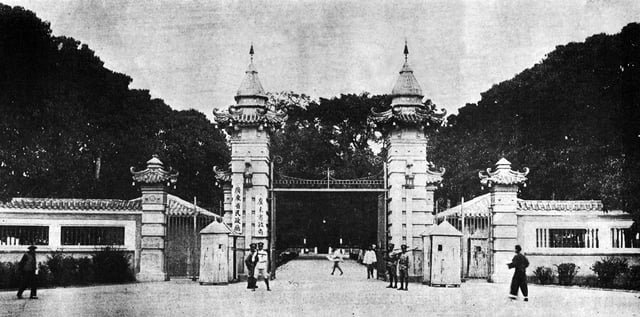
Kwangtung Provincial Government of the Republic of China
The Neolithic era began in the Pearl River Delta (珠江三角洲) 7,000 years before present (BP), with the early period from around 7000 to 5000 BP (c. 5050–3050 BC), and the late period from about 5000 to 3500 BP (c. 3050–1550 BC). In coastal Guangdong, the Neolithic was likely introduced from the middle Yangtze River area (Jiao 2013). In inland Guangdong, the neolithic appeared in Guangdong 4,600 years before present (BP). The Neolithic in northern inland Guangdong is represented by the Shixia culture (石峽文化), which occurred from 4600–4200 BP (c. 2650–2250 BC).[29]
Originally inhabited by a mixture of tribal groups known to the Chinese as the Baiyue ("Hundred Yue"), the region first became part of China during the Qin dynasty. Under the Qin Dynasty, Chinese administration began and along with it reliable historical records in the region. After establishing the first unified Chinese empire, the Qin expanded southwards and set up Nanhai Commandery at Panyu, near what is now part of Guangzhou. The region was an independent kingdom as Nanyue between the fall of Qin and the reign of Emperor Wu of Han. The Han dynasty administered Guangdong, Guangxi, and northern Vietnam as Jiaozhi Province, southernmost Jiaozhi Province was used as a gateway for traders from the west—as far away as the Roman Empire. Under the Wu Kingdom of the Three Kingdoms period, Guangdong was made its own province, the Guang Province, in 226 CE.
As time passed, the demographics of what is now Guangdong gradually shifted to (Han) Chinese dominance as the populations intermingled due to commerce along the great canals, and abruptly shifted through massive migration from the north during periods of political turmoil and nomadic incursions from the fall of the Han dynasty onwards. For example, internal strife in northern China following the rebellion of An Lushan resulted in a 75% increase in the population of Guangzhou prefecture between the 740s–750s and 800s–810s.[30] As more migrants arrived, the local population was gradually assimilated to Han Chinese culture[31] or displaced.
Together with Guangxi, Guangdong was made part of Lingnan Circuit (political division Circuit), or Mountain-South Circuit, in 627 during the Tang dynasty. The Guangdong part of Lingnan Circuit was renamed Guangnan East Circuit guǎng nán dōng lù in 971 during the Song dynasty (960–1279). "Guangnan East" (廣南東) is the source of the name "Guangdong" (廣東; 广东).[32] []
As Mongols from the north engaged in their conquest of China in the 13th century, the Southern Song court fled southwards from its capital in Hangzhou. The defeat of the Southern Song court by Mongol naval forces in The Battle of Yamen 1279 in Guangdong marked the end of the Southern Song dynasty (960–1279).[33]
During the Mongol Yuan dynasty, large parts of current Guangdong belonged to Jiangxi.[34] Its present name, "Guangdong Province" was given in early Ming dynasty.
Since the 16th century, Guangdong has had extensive trade links with the rest of the world. European merchants coming northwards via the Straits of Malacca and the South China Sea, particularly the Portuguese and British, traded extensively through Guangzhou. Macau, on the southern coast of Guangdong, was the first European settlement in 1557.
In the 19th century, the opium traded through Guangzhou triggered the First Opium War, opening an era of Western imperialists' incursion and intervention in China. In addition to Macau, which was then a Portuguese colony, Hong Kong was ceded to the British, and Kwang-Chou-Wan (modern day area of Zhanjiang) to the French.
Due to the large number of people that emigrated out of the Guangdong province, and in particular the ease of immigration from Hong Kong to other parts of the British Empire(later British Commonwealth), many overseas Chinese communities have their origins in Guangdong and/or Cantonese culture. In particular, the Cantonese and Teochew dialects have proportionately more speakers among overseas Chinese people than Mandarin-speaking Chinese. Additionally, many Cantonese-speaking Chinese emigrated to Western countries, with the results that many Western versions of Chinese words were derived from the Cantonese dialects rather than through the main stream Mandarin language, such as "dim sum". Some Mandarin Chinese words originally of foreign origin also came from the original foreign language by way of Cantonese. For example, the Mandarin word níngméng (simplified Chinese: 柠檬; traditional Chinese: 檸檬), meaning "Lemon", came from Cantonese, in which the characters are pronounced as lìng mung.[35] In the United States, there is a large number of Chinese who are descendants of immigrants from the county-level city of Taishan (Toisan in Cantonese), who speak a distinctive dialect related to Cantonese called Taishanese (or Toishanese).
During the 1850s, the Taiping Rebellion, whose leader Hong Xiuquan was born in Guangdong and received a pamphlet from a Protestant Christian missionary in Guangdong, became a widespread civil war in southern China. Because of direct contact with the West, Guangdong was the center of anti-Manchu and anti-imperialist activity. The generally acknowledged founder of modern China, Sun Yat-sen, was also from Guangdong.
During the early 1920s of the Republic of China, Guangdong was the staging area for the Kuomintang (KMT) to prepare for the Northern Expedition, an effort to bring the various warlords of China back under a unified central government. Whampoa Military Academy was built near Guangzhou to train military commanders.
In recent years, the province has seen extremely rapid economic growth, aided in part by its close trading links with Hong Kong, which borders it. It is now the province with the highest gross domestic product in China.
In 1952, a small section of Guangdong's coastline was given to Guangxi, giving it access to the sea. This was reversed in 1955, and then restored in 1965. Hainan Island was originally part of Guangdong, but it was separated into its own province in 1988.
Geography

Pearl River and Humen Bridge
Guangdong faces the South China Sea to the south and has a total of 4,300 km (2,700 mi) of coastline. The Leizhou Peninsula is on the southwestern end of the province. There are a few inactive volcanoes on Leizhou Peninsula. The Pearl River Delta is the convergent point of three upstream rivers: the East River, North River, and West River. The river delta is filled with hundreds of small islands. The province is geographically separated from the north by a few mountain ranges collectively called the Nan Mountains (Nan Ling). The highest peak in the province is Shikengkong with an elevation of 6,240 feet (1,902 meters) above sea level.
Guangdong borders Fujian to the northeast, Jiangxi and Hunan to the north, Guangxi autonomous region to the west, and Hong Kong and Macau Special Administrative Regions to the south. Hainan is offshore across from the Leizhou Peninsula. The Pratas Islands, which were traditionally governed as part of Guangdong, are now administered by the Republic of China on Taiwan.[36]
Guangdong has a humid subtropical climate (Köppen Cfa inland, Cwa along the coast), though nearing a tropical climate in the far south. Winters are short, mild, and relatively dry, while summers are long, hot, and very wet. Average daily highs in Guangzhou in January and July are 18 °C (64 °F) and 33 °C (91 °F), respectively, although the humidity makes it feel much hotter in summer. Frost is rare on the coast but may happen a few days each winter well inland.
Economy
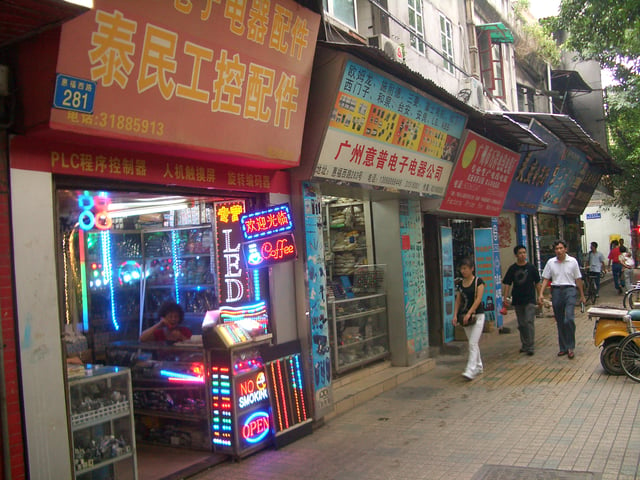
Shops in one of the streets of Guangzhou specialize in selling various electronic components, supplying the needs of local consumer electronics manufacturers. The shop in front is in the LED business.
The economy of Guangdong is large enough to be compared to that of many countries. In 2017, the gross domestic product (GDP) is about $1331.19 billion, Guangdong has been the largest province by GDP since 1989 in Mainland China. Guangdong is responsible for 10.87 percent of the China' $12.25 trillion GDP.[37] In 2015, Guangdong's GDP was slightly larger than that of Mexico ranking 15th in terms of US dollar or Purchasing Power Parity. Comparable to that of country subdivisions in dollar terms, Guangdong's GDP is larger than that of all but 6 country subdivisions: England, California, Texas, New York and Tokyo. It is comparable to the GDP of the Los Angeles metropolitan area.
This is a trend of official estimates [76] of the gross domestic product of the Province of Guangdong with figures in millions of Chinese Yuan:
| Historical GDP of Guangdong Province for 1978 –present (SNA2008)[38] (purchasing power parity of Chinese Yuan, as Int'l.dollar based on IMF WEO October 2017[39]) | |||||||||
| year | GDP | **GDP per capita (GDPpc) ** based on mid-year population | Reference index | ||||||
| GDP in millions | real growth (%) | GDPpc | exchange rate *1 foreign currency to CNY* | ||||||
| CNY | USD | PPP (Int'l$.) | CNY | USD | PPP (Int'l$.) | USD 1 | Int'l$. 1 (PPP) | ||
| 2016 | 8,085,491 | 1,217,273 | 2,306,121 | 7.5 | 74,016 | 11,143 | 21,111 | 6.6423 | 3.5061 |
| 2015 | 7,402,743 | 1,188,546 | 2,085,809 | 8.0 | 68,629 | 11,019 | 19,337 | 6.2284 | 3.5491 |
| 2014 | 6,890,143 | 1,121,662 | 1,940,721 | 7.8 | 64,491 | 10,499 | 18,165 | 6.1428 | 3.5503 |
| 2013 | 6,345,544 | 1,024,599 | 1,774,034 | 8.5 | 59,756 | 9,649 | 16,706 | 6.1932 | 3.5769 |
| 2012 | 5,799,354 | 918,710 | 1,633,253 | 8.2 | 54,973 | 8,709 | 15,482 | 6.3125 | 3.5508 |
| 2011 | 5,395,920 | 835,437 | 1,539,273 | 10.0 | 51,523 | 7,977 | 14,698 | 6.4588 | 3.5055 |
| 2010 | 4,657,712 | 688,044 | 1,406,909 | 12.4 | 45,284 | 6,689 | 13,678 | 6.7695 | 3.3106 |
| 2005 | 2,272,329 | 277,394 | 794,799 | 14.1 | 24,828 | 3,031 | 8,684 | 8.1917 | 2.8590 |
| 2000 | 1,081,021 | 130,583 | 397,536 | 11.5 | 12,818 | 1,548 | 4,714 | 8.2784 | 2.7193 |
| 1990 | 155,903 | 32,594 | 91,568 | 11.6 | 2,484 | 519 | 1,459 | 4.7832 | 1.7026 |
| 1980 | 24,965 | 16,661 | 16,693 | 16.6 | 481 | 321 | 322 | 1.4984 | 1.4955 |
| 1978 | 18,585 | 11,039 | 1.0 | 370 | 220 | 1.6836 | |||
After the communist revolution and until the start of the Deng Xiaoping reforms in 1978, Guangdong was an economic backwater, although a large underground, service-based economy has always existed. Economic development policies encouraged industrial development in the interior provinces which were weakly joined to Guangdong via transportation links. The government policy of economic autarky made Guangdong's access to the ocean irrelevant.
Deng Xiaoping's open door policy radically changed the economy of the province as it was able to take advantage of its access to the ocean, proximity to Hong Kong, and historical links to overseas Chinese. In addition, until the 1990s when the Chinese taxation system was reformed, the province benefited from the relatively low rate of taxation placed on it by the central government due to its post-Liberation status of being economically backward.
Guangdong's economic boom began with the early 1990s and has since spread to neighboring provinces, and also pulled their populations inward. The economic growth of Guangdong province owes much to the low-value-added manufacturing which characterized (and in many ways still defines) the province's economy following Deng Xiaoping's reforms. Guangdong is not only China's largest exporter of goods, it is the country's largest importer as well.[40]
The province is now one of the richest in the nation, with the most billionaires in mainland China,[41] the highest GDP among all the provinces, although wage growth has only recently begun to rise due to a large influx of migrant workers from neighboring provinces. In 2011, Guangdong's aggregate nominal GDP reached 5.30 trillion RMB (US$838.60 billion) with a per capita GDP of 47,689 RMB.[42] By 2015, the local government of Guangdong hopes that the service industry will account for more than 50 percent of the provinces GDP and high-tech manufacturing another 20 percent.[40]
In 2009, Guangdong's primary, secondary, and tertiary industries were worth 201 billion yuan, 1.93 trillion yuan, and 1.78 trillion yuan, respectively.[43] Its per capita GDP reached 40,748 yuan (about US$5,965).[44] Guangdong contributes approximately 12% of the total national economic output.[45] Now, it has three of the six Special Economic Zones: Shenzhen, Shantou and Zhuhai. The affluence of Guangdong, however, remains very concentrated near the Pearl River Delta.
In 2008 its foreign trade also grew 7.8% from the previous year and is also by far the largest of all of China. By numbers, Guangdong's foreign trade accounts for more than a quarter of China's US$2.56 trillion foreign trade or roughly US$683 billion.[46]
Economic and technological development zones
Shenzhen Export Processing Zone
Shenzhen Futian Free Trade Zone[47]
Shenzhen Hi-Tech Industrial Park
Yantian Port Free Trade Zone
Foshan National New & Hi-Tech Industrial Development Zone[48]
Guangzhou Development District
Guangzhou Export Processing Zone
Guangzhou Free Trade Zone
Guangzhou Nansha Economic and Technical Development Zone
Guangzhou Nanhu Lake Tourist Holiday Resort (Chinese Version)
Guangzhou New & Hi-Tech Industrial Development Zone
Huizhou Dayawan Economic and Technological Development Zone
Huizhou Export Processing Zone
Huizhou Zhongkai Hi-Tech Development Zone
Nansha Free Trade Zone
Shantou Free Trade Zone
Shatoujiao Free Trade Zone
Zhanjiang Economic and Technological Development Zone (Chinese Version)
Zhuhai National Hi-Tech Industrial Development Zone
Zhuhai Free Trade Zone
Zhongshan Torch High-tech Industrial Development Zone
Demographics

Guangzhou is the third largest city in the People's Republic of China
| Historical population | ||
|---|---|---|
| Year | Pop. | ±% |
| 1912[49] | 28,011,000 | — |
| 1928[50] | 32,428,000 | +15.8% |
| 1936-37[51] | 32,453,000 | +0.1% |
| 1947[52] | 27,210,000 | −16.2% |
| 1954[53] | 34,770,059 | +27.8% |
| 1964[54] | 42,800,849 | +23.1% |
| 1982[55] | 59,299,220 | +38.5% |
| 1990[56] | 62,829,236 | +6.0% |
| 2000[57] | 85,225,007 | +35.6% |
| 2010[58] | 104,303,132 | +22.4% |
| Hainan Province part of Guangdong Province until 1988. Guangzhou part of Guangdong Province until 1947; dissolved in 1954 and incorporated into Guangdong Province. | ||
Guangdong officially became the most populous province in 2005.[15][16] Official statistics had traditionally placed Guangdong as the 4th-most populous province of China with about 80 million people, though an influx of migrants, temporary workers, and newly settled individuals numbered around 30 million.[59] The massive influx of migrants from other provinces, dubbed the "floating population", is due to Guangdong's booming economy and high demand for labor. If Guangdong were an independent nation, it would rank among the twenty largest countries of the world by population, more populous than France, Germany, or the United Kingdom, and more populous than the largest three US states (California, Texas, and Florida) combined. Guangdong's population is 70.7% urban and 29.3% rural.[10]
Guangdong is also the ancestral home of large numbers of overseas Chinese. Most of the railroad laborers in Canada, Western United States and Panama in the 19th century came from Guangdong. Many people from the region also travelled to the US / California during the gold rush of 1849, and also to Australia during its gold rush a decade or so later.
The majority of the province's population is Han Chinese. Within the Han Chinese, the largest subgroup in Guangdong are the Cantonese people. Two other major groups are the Teochew people in Chaoshan and the Hakka people in Huizhou, Meizhou, Heyuan, Shaoguan and Zhanjiang. There is a small Yao population in the north. Other smaller minority groups include She, Miao, Li, and Zhuang.
Guangdong has a highly unbalanced gender ratio that is among the highest of all provinces in China. According to a 2009 study published in the British Medical Journal, in the 1–4 age group, there are over 130 boys for every 100 girls.[62]
Religion
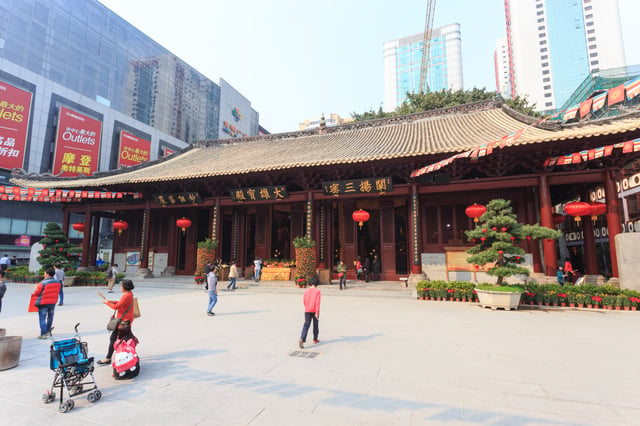
Temple of the Great Buddha in Guangzhou.
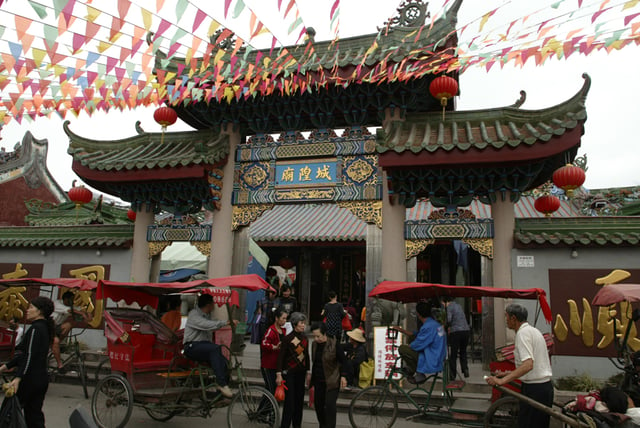
Temple of the Chenghuangshen (City God) of Jieyang.
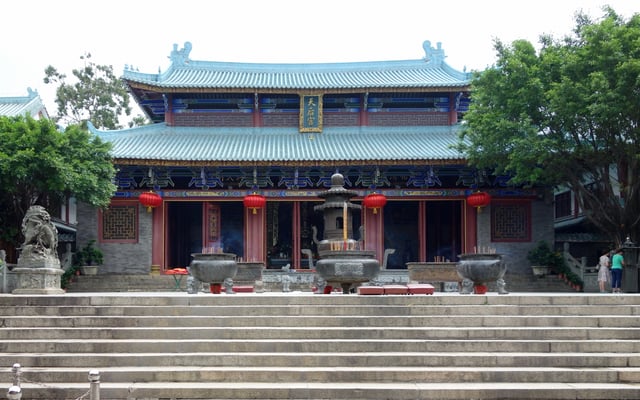
Temple of Tianhou in Chiwan, Shenzhen.
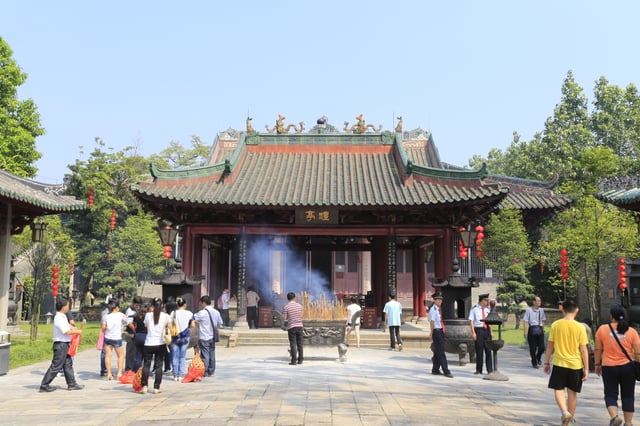
Temple of Nanhaishen (God of the Southern Sea) in Guangzhou.
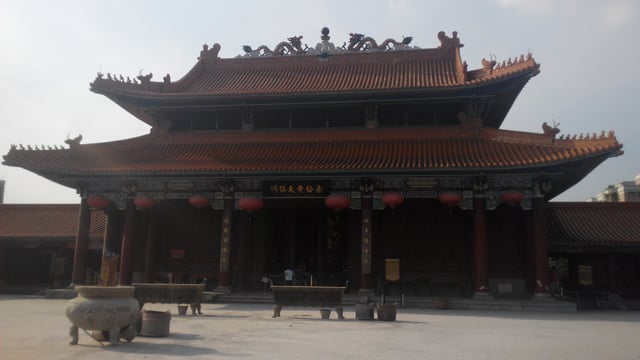
Temple of Huang Daxian in Guangzhou.

The Buddhist Yuhua Temple in Ronggui, Shunde.
According to a 2012 survey[60] only around 7% of the population of Guangdong belongs to organised religions, the largest groups being Buddhists with 6.2%, followed by Protestants with 0.8% and Catholics with 0.2%. Around 93% of the population is either irreligious or may be involved in Chinese folk religions worshipping nature gods, ancestral deities, popular sects, Taoist traditions, Buddhist religious traditions & Confucian religious traditions.
According to a survey conducted in 2007, 43.71% of the population believes and is involved in ancestor veneration,[63] the traditional Chinese religion of the lineages organised into lineage churches and ancestral shrines.
Politics
Guangdong is governed by a dual-party system like the rest of China. The Governor is in charge of provincial affairs; however, the Communist Party Secretary, often from outside of Guangdong, keeps the Governor in check.
Relations with Hong Kong and Macau
Hong Kong and Macau, while historically parts of Guangdong before becoming colonies of the United Kingdom and Portugal, respectively, are special administrative regions (SARs). Furthermore, the Basic Laws of both SARs explicitly forbid provincial governments from intervening in local politics. As a result, many issues with Hong Kong and Macau, such as border policy and water rights, have been settled by negotiations between the SARs' governments and the Guangdong provincial government.
Media
Guangdong and the greater Guangzhou area are served by several Radio Guangdong stations, Guangdong Television, Southern Television Guangdong, Shenzhen Television, and Guangzhou Television. There is an English programme produced by Radio Guangdong which broadcasts information about this region to the entire world through the WRN Broadcast.
Culture
The central region, which is also the political and economic center, is populated predominantly by Yue Chinese speakers, though the influx in the last three decades of millions of Mandarin-speaking immigrants has slightly diminished Cantonese linguistic dominance. This region is associated with Cantonese cuisine. Cantonese opera is a form of Chinese opera popular in Cantonese speaking areas. Related Yue dialects are spoken in most of the western half of the province.
The area comprising the cities of Chaozhou, Shantou and Jieyang in coastal east Guangdong, known as Chaoshan, forms its own cultural sphere. The Teochew people here, along with Hailufeng people in Shanwei, speak Teochew, which is a Min dialect closely related to mainstream Southern Min (Hokkien) and their cuisine is Teochew cuisine. Teochew opera is also well-known and has a unique form.
The Hakka people live in large areas of Guangdong, including Huizhou, Meizhou, Shenzhen, Heyuan, Shaoguan and other areas. Much of the Eastern part of Guangdong is populated by the Hakka people except for the Chaozhou and Hailufeng area. Hakka culture include Hakka cuisine, Han opera (simplified Chinese: 汉剧; traditional Chinese: 漢劇), Hakka Hanyue and sixian (traditional instrumental music) and Hakka folk songs (客家山歌).
Zhanjiang in southern Guangdong is dominated by the Leizhou dialect, a variety of Minnan; Cantonese and Hakka are also spoken there.
Mandarin is the language used in education and government and in areas where there are migrants from other provinces, above all in Shenzhen. Cantonese maintains a strong and dominant position in common usage and media, even in eastern areas of the province where the local languages and dialects are non-Yue ones.
Guangdong Province is notable for being the birthplace of many famed Xiangqi (Chinese chess) grandmasters such as Lü Qin, Yang Guanli, Cai Furu and Xu Yinchuan.
Education
Guangdong Province Department of Education is the department of the provincial government that oversees education.
Colleges and universities
National
Sun Yat-sen University
South China University of Technology
Jinan University
South China Agricultural University
Guangdong University of Foreign Studies
Guangzhou University of Chinese Medicine
Provincial
Dongguan Institute of Technology
Dongguan University of Technology
Foshan University
Guangdong Education and Research Network
Guangdong General Hospital
Guangdong Institute of Education
Guangdong Institute of Science and Technology
Guangdong Medical College
Guangdong Ocean University
Guangdong Petrochemical Academy
Guangdong Pharmaceutical University
Guangdong Polytechnic Normal University
Guangdong Radio and TV University
Guangdong University of Finance & Economics
Guangdong University of Finance
Guangdong University of Technology
Guangzhou Academy of Fine Arts
Guangzhou Education College
Guangzhou Medical College
Guangzhou Normal University
Guangzhou Sports University
Guangzhou University
Hanshan Teachers College
Huizhou University
Panyu Polytechnic
Shaoguan University
Shenzhen Party School
Shantou University
Shenzhen University
Shenzhen Technology University
Shenzhen Polytechnic
Shunde University
South China Normal University
South University of Science and Technology of China
Southern Medical University
Wuyi University
Xijiang University
Xinghai Conservatory of Music
Zhanjiang Normal University
Zhongkai University of Agriculture and Engineering
Zhaoqing University
Sports
List of current professional sports based in Guangdong:
| Sport | League | Tier | Club | City | Stadium |
|---|---|---|---|---|---|
| Football | Chinese Super League | 1st | Guangzhou Evergrande Taobao F.C. | Guangzhou | Tianhe Stadium |
| Football | Chinese Super League | 1st | Guangzhou R&F F.C. | Guangzhou | Yuexiushan Stadium |
| Football | Hong Kong Premier League | 1st | R&F | Guangzhou | Yanzigang Stadium |
| Football | China League One | 2nd | Shenzhen F.C. | Shenzhen | Shenzhen Stadium |
| Football | China League One | 2nd | Meizhou Hakka F.C. | Wuhua | Wuhua County Stadium |
| Football | China League One | 2nd | Meizhou Meixian Techand F.C. | Meizhou | Meixian Tsang Hin-chi Stadium |
| Football | China League Two | 3rd | Shenzhen Ledman F.C. | Shenzhen | Bao'an Stadium |
| Football | China League Two | 3rd | Shenzhen Pengcheng F.C. | Shenzhen | Xixiang Sports Center |
| Football | China Women's League One | 2nd | Meizhou Hunjun | Wuhua | Wuhua County Stadium |
| Futsal | China Futsal Super League | 1st | Shenzhen Nanling Tielang | Shenzhen | Qiushanshui Park Sports Centre |
| Futsal | China Futsal Super League | 1st | Yingde Yanjiyou | Yingde | Yingde Gymnasium |
| Futsal | China Futsal Super League | 1st | Zhuhai Mingshi | Zhuhai | Zhuhai Sports Centre |
| Basketball | Chinese Basketball Association | 1st | Guangdong Southern Tigers | Dongguan | Nissan Sports Centre |
| Basketball | Chinese Basketball Association | 1st | Shenzhen Leopards | Shenzhen | Shenzhen Universiade Sports Centre |
| Basketball | Chinese Basketball Association | 1st | Guangzhou Long-Lions | Guangzhou | Tianhe Gymnasium |
| Basketball | ASEAN Basketball League | 1st | Zhuhai Wolf Warriors | Zhuhai | Jinan University (Zhuhai Campus) |
| Basketball | Women's Basketball Association | 1st | Guangdong Asia Aluminum | Zhaoqing | Zhaoqing Stadium |
| Volleyball | Men's Volleyball League Div A | 1st | Guangdong GSports | Shenzhen | Shenzhen Gymnasium |
| Volleyball | Women's Volleyball League Div A | 1st | Guangdong Evergrande | Shenzhen | Shenzhen Gymnasium |
| Volleyball | Women's Volleyball League Div B | 2nd | Guangdong Jianlong | Taishan | Taishan Stadium |
| Baseball | China Baseball League | 1st | Guangdong Leopards | Guangzhou | Huangcun Stadium |
| Table Tennis | China Table Tennis Super League | 1st | Shenzhen Bao'an Mingjinhai | Shenzhen | Bao'an Stadium |
Tourism
Notable attractions include Danxia Mountain in Shaoguan, Yuexiu Hill, Baiyun Mountain in Guangzhou, Star Lake and the Seven Star Crags, Dinghu Mountain in Zhaoqing, the Huangmanzhai waterfalls in Jieyang, and the Zhongshan Sun Wen Memorial Park for Sun Yat-sen in Zhongshan.
Administrative divisions
Guangdong is divided into twenty-one prefecture-level divisions: all prefecture-level cities (including two sub-provincial cities):
| Administrative divisions of Guangdong | |||||||||||
|---|---|---|---|---|---|---|---|---|---|---|---|
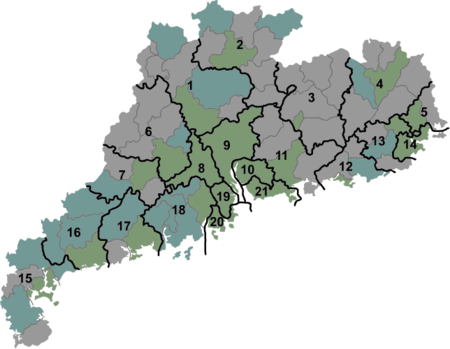 Prefecture-level city district areasCounty-level cities Prefecture-level city district areasCounty-level cities | |||||||||||
| No. | Division code[64] | prefecture level cities | Area in km2[65] | Population 2010[66] | Seat | Divisions[67] | |||||
| Districts | Counties | Aut. counties | CL cities | ||||||||
| 440000 | Guangdong Province | 179,800.00 | 104,303,132 | Guangzhou | 65 | 34 | 3 | 20 | |||
| 9 | 440100 | Guangzhou | 7,434.40 | 12,701,948 | Yuexiu District | 11 | |||||
| 2 | 440200 | Shaoguan | 18,412.53 | 2,826,246 | Zhenjiang District | 3 | 4 | 1 | 2 | ||
| 21 | 440300 | Shenzhen | 1,996.78 | 10,358,381 | Futian District | 9* | |||||
| 20 | 440400 | Zhuhai | 1,724.32 | 1,562,530 | Xiangzhou District | 3 | |||||
| 14 | 440500 | Shantou | 2,248.39 | 5,389,328 | Jinping District | 6 | 1 | ||||
| 8 | 440600 | Foshan | 3,848.49 | 7,197,394 | Chancheng District | 5 | |||||
| 18 | 440700 | Jiangmen | 9,505.42 | 4,450,703 | Pengjiang District | 3 | 4 | ||||
| 15 | 440800 | Zhanjiang | 13,225.44 | 6,994,832 | Chikan District | 4 | 2 | 3 | |||
| 16 | 440900 | Maoming | 11,424.8 | 5,817,494 | Maonan District | 2 | 3 | ||||
| 6 | 441200 | Zhaoqing | 14,891.23 | 3,916,467 | Duanzhou District | 3 | 4 | 1 | |||
| 11 | 441300 | Huizhou | 11,342.98 | 4,598,402 | Huicheng District | 2 | 3 | ||||
| 4 | 441400 | Meizhou | 15,864.51 | 4,238,461 | Meijiang District | 2 | 5 | 1 | |||
| 12 | 441500 | Shanwei | 4,861.79 | 2,935,469 | Cheng District | 1 | 2 | 1 | |||
| 3 | 441600 | Heyuan | 15,653.63 | 2,950,195 | Yuancheng District | 1 | 5 | ||||
| 17 | 441700 | Yangjiang | 7,955.27 | 2,421,748 | Jiangcheng District | 2 | 1 | 1 | |||
| 1 | 441800 | Qingyuan | 19,152.90 | 3,698,412 | Qingcheng District | 2 | 2 | 2 | 2 | ||
| 10 | 441900 | Dongguan ** | 2,465.00 | 8,220,207 | Nancheng Subdistrict | ||||||
| 19 | 442000 | Zhongshan ** | 1,783.67 | 3,121,275 | Dongqu Subdistrict | ||||||
| 5 | 445100 | Chaozhou | 3,145.89 | 2,669,466 | Xiangqiao District | 2 | 1 | ||||
| 13 | 445200 | Jieyang | 5,265.38 | 5,884,347 | Rongcheng District | 2 | 2 | 1 | |||
| 7 | 445300 | Yunfu | 7,779.12 | 2,367,154 | Yuncheng District | 2 | 2 | 1 | |||
Sub-provincial cities *- not including the new districts which are not registered under the Ministry of Civil Affairs (not included in the total Districts' count)**- direct-piped cities - does not contain any county-level divisions | |||||||||||
| Administrative divisions in Chinese and varieties of romanizations | ||||
|---|---|---|---|---|
| English | Chinese | Pinyin | Guangdong Romanization | |
| Guangdong Province | 广东省 | Guǎngdōng Shěng | guong2 dung1 sang2 | |
| Guangzhou City | 广州市 | Guǎngzhōu Shì | guong2 zeo1 xi5 | |
| Shaoguan City | 韶关市 | Sháoguān Shì | xiu4 guan1 xi5 | |
| Shenzhen City | 深圳市 | Shēnzhèn Shì | sem1 zen3 xi5 | |
| Zhuhai City | 珠海市 | Zhūhǎi Shì | ju1 hoi2 xi5 | |
| Shantou City | 汕头市 | Shàntóu Shì | san3 teo4 xi5 | |
| Foshan City | 佛山市 | Fóshān Shì | fed6 san1 xi5 | |
| Jiangmen City | 江门市 | Jiāngmén Shì | gong1 mun4 xi5 | |
| Zhanjiang City | 湛江市 | Zhànjiāng Shì | zam3 gong1 xi5 | |
| Maoming City | 茂名市 | Màomíng Shì | meo6 ming4 xi5 | |
| Zhaoqing City | 肇庆市 | Zhàoqìng Shì | xiu6 hing3 xi5 | |
| Huizhou City | 惠州市 | Huìzhōu Shì | wei6 zeo1 xi5 | |
| Meizhou City | 梅州市 | Méizhōu Shì | mui4 zeo1 xi5 | |
| Shanwei City | 汕尾市 | Shànwěi Shì | san3 méi5 xi5 | |
| Heyuan City | 河源市 | Héyuán Shì | ho4 yun4 xi5 | |
| Yangjiang City | 阳江市 | Yángjiāng Shì | yêng4 gong1 xi5 | |
| Qingyuan City | 清远市 | Qīngyuǎn Shì | qing1 yun5 xi5 | |
| Dongguan City | 东莞市 | Dōngguǎn Shì | dung1 gun2 xi5 | |
| Zhongshan City | 中山市 | Zhōngshān Shì | zung1 san1 xi5 | |
| Chaozhou City | 潮州市 | Cháozhōu Shì | qiu4 zeo1 xi5 | |
| Jieyang City | 揭阳市 | Jiēyáng Shì | kid3 yêng4 xi5 | |
| Yunfu City | 云浮市 | Yúnfú Shì | wen4 feo4 xi5 | |
The twenty-one Prefecture of Guangdong are subdivided into 119 county-level divisions (64 districts, 20 county-level cities, 34 counties, and 3 autonomous counties). For county-level divisions, see the list of administrative divisions of Guangdong.
Urban areas
| Population by urban areas of prefecture & county cities | |||||
|---|---|---|---|---|---|
| Cities | Urban area[68] | District area[68] | City proper[68] | Census date | |
| 1 | Shenzhen | 10,358,381 | 10,358,381 | 10,358,381 | 2010-11-01 |
| 2 | Guangzhou[1] | 9,702,144 | 11,071,424 | 12,701,948 | 2010-11-01 |
| (2) | Guangzhou(new districts)[1] | 939,264 | 1,630,524 | see Guangzhou | 2010-11-01 |
| 3 | Dongguan | 7,271,322 | 8,220,207 | 8,220,207 | 2010-11-01 |
| 4 | Foshan | 6,771,895 | 7,197,394 | 7,197,394 | 2010-11-01 |
| 5 | Shantou | 3,644,017 | 5,329,024 | 5,389,328 | 2010-11-01 |
| 6 | Zhongshan | 2,740,994 | 3,121,275 | 3,121,275 | 2010-11-01 |
| 7 | Huizhou | 1,807,858 | 2,344,634 | 4,598,402 | 2010-11-01 |
| 8 | Jiangmen | 1,480,023 | 1,822,614 | 4,450,703 | 2010-11-01 |
| 9 | Zhuhai | 1,369,538 | 1,562,530 | 1,562,530 | 2010-11-01 |
| 10 | Zhanjiang | 1,038,762 | 1,611,868 | 6,994,832 | 2010-11-01 |
| 11 | Puning | 874,954 | 2,055,552 | see Jieyang | 2010-11-01 |
| 12 | Jieyang[2] | 734,670 | 746,354 | 5,884,347 | 2010-11-01 |
| (12) | Jieyang(new district)[2] | 492,178 | 1,159,118 | see Jieyang | 2010-11-01 |
| 13 | Shaoguan | 726,267 | 991,600 | 2,826,246 | 2010-11-01 |
| 14 | Qingyuan[3] | 639,659 | 811,233 | 3,698,412 | 2010-11-01 |
| (14) | Qingyuan(new district)[3] | 276,794 | 698,811 | see Qingyuan | 2010-11-01 |
| 15 | Maoming[4] | 637,879 | 1,217,596 | 5,817,494 | 2010-11-01 |
| (15) | Maoming(new district)[4] | 395,317 | 1,218,716 | see Maoming | 2010-11-01 |
| 16 | Lufeng | 579,527 | 1,358,265 | see Shanwei | 2010-11-01 |
| 17 | Zhaoqing[5] | 559,887 | 644,032 | 3,916,467 | 2010-11-01 |
| (17) | Zhaoqing(new district)[5] | 224,755 | 753,120 | see Zhaoqing | 2010-11-01 |
| 18 | Yangjiang[6] | 499,053 | 676,857 | 2,421,748 | 2010-11-01 |
| (18) | Yangjiang(new district)[6] | 193,487 | 442,762 | see Yangjiang | 2010-11-01 |
| 19 | Heyuan | 450,953 | 463,907 | 2,950,195 | 2010-11-01 |
| 20 | Chaozhou[7] | 448,226 | 452,469 | 2,669,466 | 2010-11-01 |
| (20) | Chaozhou(new district)[7] | 808,042 | 1,334,796 | see Chaozhou | 2010-11-01 |
| 21 | Taishan | 394,855 | 941,095 | see Jiangmen | 2010-11-01 |
| 22 | Xingning | 392,000 | 962,883 | see Meizhou | 2010-11-01 |
| 23 | Kaiping | 371,019 | 699,242 | see Jiangmen | 2010-11-01 |
| 24 | Shanwei | 370,608 | 492,262 | 2,935,469 | 2010-11-01 |
| 25 | Lianjiang | 359,225 | 927,275 | see Zhanjiang | 2010-11-01 |
| 26 | Sihui | 355,709 | 542,873 | see Zhaoqing | 2010-11-01 |
| 27 | Meizhou[8] | 353,769 | 380,771 | 4,238,461 | 2010-11-01 |
| (27) | Meizhou(new district)[8] | 258,782 | 554,745 | see Meizhou | 2010-11-01 |
| 28 | Gaozhou | 352,006 | 1,288,665 | see Maoming | 2010-11-01 |
| 29 | Yingde | 346,927 | 941,952 | see Qingyuan | 2010-11-01 |
| 30 | Leizhou | 344,043 | 1,427,664 | see Zhanjiang | 2010-11-01 |
| 31 | Xinyi | 333,965 | 913,708 | see Maoming | 2010-11-01 |
| 32 | Wuchuan | 332,672 | 1,443,099 | see Zhanjiang | 2010-11-01 |
| 33 | Huazhou | 320,418 | 1,178,809 | see Maoming | 2010-11-01 |
| 34 | Heshan | 282,580 | 494,938 | see Jiangmen | 2010-11-01 |
| 35 | Luoding | 263,338 | 959,006 | see Yunfu | 2010-11-01 |
| 36 | Enping | 244,257 | 492,814 | see Jiangmen | 2010-11-01 |
| 37 | Yunfu[9] | 242,040 | 318,145 | 2,367,154 | 2010-11-01 |
| (37) | Yunfu(new district)[9] | 56,874 | 269,636 | see Yunfu | 2010-11-01 |
| 38 | Lechang | 191,457 | 397,779 | see Shaoguan | 2010-11-01 |
| 39 | Lianzhou | 161,667 | 367,642 | see Qingyuan | 2010-11-01 |
| 40 | Nanxiong | 140,017 | 316,179 | see Shaoguan | 2010-11-01 |
| 41 | Yangchun | 28,739 | 849,504 | see Yangjiang | 2010-11-01 |
See also
Major national historical and cultural sites in Guangdong
Governors of Guangdong